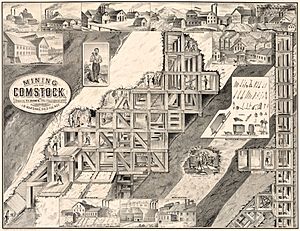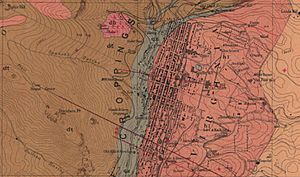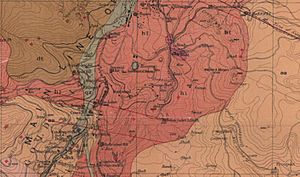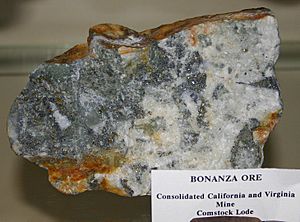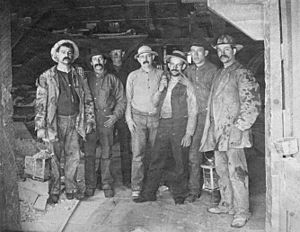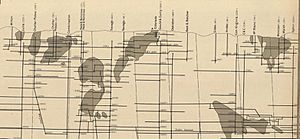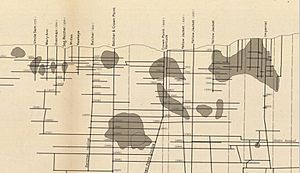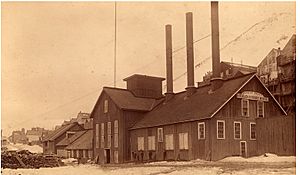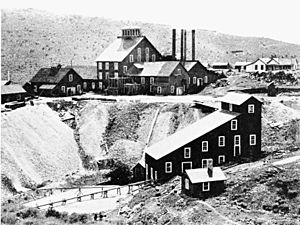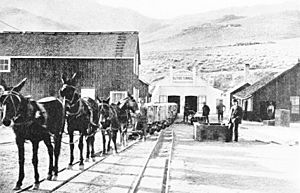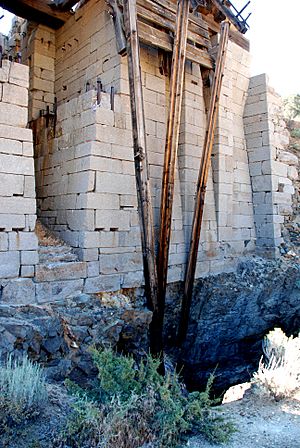Comstock Lode facts for kids
The Comstock Lode was a huge discovery of silver and gold ore located under the eastern side of Mount Davidson in Virginia City, Nevada. It was the first major silver discovery in the United States and was named after a miner named Henry Comstock.
When the discovery became public in 1859, it started a big "silver rush." Many people, called prospectors, hurried to the area to claim their share. This caused a lot of excitement, similar to the California Gold Rush of 1849. Soon, mining towns like Virginia City and Gold Hill grew quickly and became busy centers.
The Comstock Lode is famous not just for the huge wealth it created, which helped Nevada and San Francisco grow. It also led to amazing new ways of mining. These included special ways to support tunnels with wood, called square set timbering, and a new method to get silver from the ore, called the Washoe process. The mines started to produce less after 1874, but some mining continued underground until the 1920s.
Contents
How the Comstock Lode Formed
Long ago, volcanoes to the east covered the area. Then, a large crack, or fault, opened up on the eastern side of the Virginia Range. The rock on one side of this crack was called "diorite," and the rock on the other side was called "andesite" by the miners. Miners often said, "andesite makes ore," meaning it was a good sign for finding valuable minerals.
This crack filled up with "mineral-bearing quartz," which is rock containing valuable metals. The valuable ore was scattered through the wide Lode like "plums in a pudding." Most of these rich areas were found in the wider upper part and along the eastern wall. Even though miners dug in all directions, only about 16 large and rich ore bodies were found. Most of these were less than 600 feet deep.
Big Discoveries: Bonanzas
During the first five years of the Comstock Lode, six major "bonanzas" were found. A bonanza is a very rich discovery of ore.
- The Ophir bonanza was very successful until 1864. It produced 70,000 tons of ore. It was 500 feet long at the surface but became narrower at 500 feet deep.
- The Gould & Curry bonanza included part of another discovery called El Dorado. Its ore ran out by 1866.
- The Savage bonanza shared an ore body with another mine called Hale & Norcross. This ore was gone by 1869.
- The Chollar-Potosi bonanza was combined with other mines in 1865.
- The Original Gold Hill bonanza was a large area of ore, 1000 feet long, 500 feet wide, and 500 feet deep. The mines in this area joined together by 1876.
- The Yellow Jacket mine shared a bonanza with Crown Point and Kentuck, found in 1864.
The Crown Point-Belcher bonanza was found in 1870. This ore body was between 900 and 1,500 feet deep. It was 775 feet long and 120 feet wide. The ore contained slightly more gold than silver, but it only lasted for four years.
The Consolidated Virginia bonanza was discovered in March 1873, at 1,200 feet deep. This ore body was 900 feet long and 200 feet wide. It ended at 1,650 feet deep.
Finding the Silver
Gold was first found in this area in the spring of 1850 by a group of Mormon travelers. They were waiting for the mountain snow to melt so they could cross the Sierra Nevada. One of them, William Prouse, found gold by panning in the river. However, they left for California when the mountains were clear.
Other travelers followed, working in the canyon. But when the water ran out in late summer, they also moved on to California. The area didn't have people living there all year until 1852-1853. After nine years, the gold found in the riverbeds was decreasing, and many miners left.
The gold in Gold Canyon came from quartz veins higher up the stream, near where Silver City and Gold Hill are today. As miners moved up the stream, they started a town called Johntown. In 1857, miners in Johntown found gold in Six-Mile Canyon, about five miles north of Gold Canyon. These two canyons mark the north and south ends of what became the Comstock Lode.
The Grosh Brothers
Some people believe the Comstock Lode was first found in 1857 by Ethan Allen Grosh and Hosea Ballou Grosh. They were brothers, trained in minerals, and had worked in the California gold fields. Hosea died from an infection in 1857. Allen then tried to get money by traveling to California with samples and maps of their claim.
Henry Comstock was left to look after the Grosh cabin and a locked chest with ore samples and discovery papers. Allen Grosh and his friend never made it to California. They suffered from frostbite while crossing the Sierra Nevada, and Allen died in December 1857.
When Henry T. P. Comstock heard about the Grosh brothers' deaths, he claimed their cabin and land. He looked at the trunk's contents but didn't understand the papers. He did know that the gold and silver ore samples came from the same vein. He kept looking for where local miners were digging, knowing the Grosh brothers' find was still available. When he heard about a strike on Gold Hill that uncovered some bluish rock (silver ore), Comstock quickly claimed land next to it.
Gold Hill Discovery
Four miners found the Gold Hill ore at the top of Gold Canyon on January 28, 1859. They were James Finney ("Old Virginny"), John Bishop ("Big French John"), Aleck Henderson, and Jack Yount.
Other miners, including Henry Comstock, soon made claims too. In the spring of 1859, after digging about ten feet deep, they found a rich, reddish quartz vein with gold. This was actually part of the Comstock Lode, called the Old Red Ledge. These four men are therefore credited with finding the mine again after the Grosh brothers.
Ophir Discovery
In the spring of 1859, two miners, Peter O'Riley and Patrick McLaughlin, went to Six Mile Canyon. They started looking for gold with a "rocker" (a simple gold-washing device) near a small stream. They didn't find much gold in the top dirt. They were about to give up when they dug a deeper pit to collect water. At the bottom of this hole, they found "rich black sand" and gold.
Henry T. P. Comstock heard about them working on land he said he already claimed for "grazing." He was not happy with his own claim on Gold Hill. Comstock made threats and managed to get himself and his partner, Immanuel "Manny" Penrod, a share in the claim.
On June 12, as they dug a trench, they found black sand mixed with bluish-gray quartz and gold. On June 27, tests showed that this "blue stuff" was very rich sulfide of silver. It was three-fourths silver and one-fourth gold! This was the start of silver mining in America.
What Happened to the Discoverers?
The miners who found the mines and the people who bought their claims didn't know how big or rich the discovery was. It's hard to guess the size and value of a hidden ore body even today. Most thought it was a small to medium find, like most other gold strikes.
They also knew they didn't have enough money or experience to fully explore the discovery. It would take many years of hard work by thousands of miners and millions of dollars to understand its true value.
- Patrick McLaughlin sold his share in the Ophir claim for $3,000 to George Hearst. McLaughlin soon lost the money and died working odd jobs.
- Emanuel Penrod, Henry Comstock's partner, sold his shares for a total of $8,500.
- Peter O'Riley kept his Ophir interests for a while, collecting money, then sold them for about $40,000. He built a hotel in Virginia City. He later struggled with mental health, lost everything, and died in a private hospital.
- Henry Comstock traded an old horse and a bottle of whiskey for a share of the Ophir. He later sold all his Ophir shares for $11,000. He also sold his share of another mine for $5,500. He opened stores but had no business experience and went broke. After losing almost everything, he looked for gold in other states without success. In September 1870, he died from a gunshot wound.
New Ideas and Growth
Mining Techniques
At first, miners dug ore from the surface. But these easy finds quickly ran out, and miners had to dig tunnels underground. Unlike most silver deposits, which are in long, thin veins, the Comstock Lode had ore in large, thick pockets, sometimes hundreds of feet thick. The ore was often soft, making it easy to dig with a shovel. However, the surrounding rock was weak, leading to frequent and dangerous cave-ins. Miners eventually dug down more than 3,200 feet.
The problem of cave-ins was solved by a method called square set timbering, invented by Philip Deidesheimer. He was a German mining engineer from San Francisco. Instead of just supporting tunnels, he designed a system where wood timbers were set up like a cube, six feet on each side. As ore was removed, these timber cubes would replace it, creating a strong wooden frame. This allowed miners to safely work in very wide ore bodies. Deidesheimer was put in charge of the Ophir mine because of his clever idea.
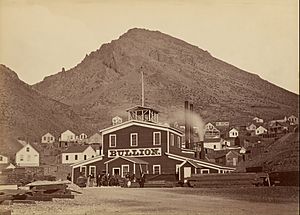
Early on, miners also had to deal with a lot of water underground. This required powerful pumps. As they dug deeper, the water became hot, hot enough to cook an egg or badly burn a person. This hot water meant they needed fans and other ventilation systems to bring cool air to the miners.
New technologies were also used, like compressed air to power drills and small lifting machines. New explosives were developed for blasting rock.
Improvements were also made to the lifting machines and cages used to bring ore to the surface and move miners. At first, they used hemp ropes, but these became too heavy as the mines got deeper. Then, iron chains were used, but they could break. In 1864, Andrew Smith Hallidie made wire rope, which was much stronger. This wire rope was used in the Comstock Lode's lifting machines and later in San Francisco's famous cable cars.
Another safety invention was spring-loaded cages. If the rope or chain broke, springs would force rods on the cage to dig into the wooden guides in the shaft, stopping the cage from falling.
Processing the Ore
In 1859, Americans didn't know much about silver mining. Mexican miners used simple methods like arastras (stone mills) and smelting in adobe furnaces. But these were too slow for the large amounts of ore being dug up. Americans introduced stamp mills to crush the ore and pans to speed up the process of amalgamation (mixing with mercury to separate the metals).
German miners, trained in mining, helped improve things. The Comstock mines eventually developed the Washoe process. This used steam-heated iron pans, which could process ore in hours, instead of the weeks it took with older methods.
In the early days, a lot of valuable metals and mercury were lost during processing. Many people tried different secret methods, even using things like cedar bark and sagebrush tea! Millions of dollars in gold, silver, and mercury were washed away into the rivers. The Carson River and Lake Lahontan still have warnings about mercury pollution. Even with improvements, the processing methods were not perfect.
Support for the Mines
Transportation
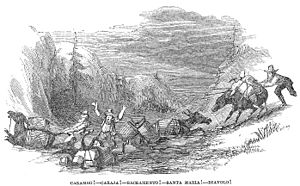
Before railroads, all goods and people were moved by teams of 10 to 16 horses or mules. These teams hauled ore to the mills and brought lumber to the mines. It's estimated that 80 million feet of timber were used each year in the Comstock mines. Forests were cut down for housing, buildings, heating, and fuel for steam engines.
Teams also brought all the mining machinery and supplies over the Sierra Nevada mountains from California. Long lines of wagons, sometimes one to three miles long, would move along the roads.
In 1869, work began on the Virginia and Truckee Railroad. By January 1870, the difficult section from Virginia City to Carson City was finished. The rails were extended north to Reno, connecting with the Central Pacific Railroad. This made transportation much faster and easier.
The Virginia and Gold Hill Water Company
When silver was first found, natural springs provided enough water for the miners and towns. But as the population grew, more water was needed for homes, mills, and steam boilers. It became impossible to supply enough water. So, the Virginia and Gold Hill Water Company was formed.
They soon ran out of water from local wells and tunnels. They had to look to the main Sierra Nevada mountains, where there was plenty of water. Between the Sierra and Virginia ranges was the Washoe Valley, a deep dip of nearly 2,000 feet. Hermann Schussler, a famous engineer, was hired to design a new water system.
Surveys were done in 1872, and the first pipes were laid in June 1873. The main pipe was made of wrought iron, over seven miles long, and 12 inches wide. It could carry 2.2 million gallons of water per day. The pipe went across the Washoe Valley like an upside-down U-shape, with water being pushed through at very high pressure. Water was brought to the pipe from the Sierra Nevada mountains using large covered channels called flumes.
The first water reached Gold Hill and Virginia City on August 1, 1873, with great celebration. This was the highest pressure water system in the world at the time. The water company added more pipes in 1875 and 1877 to deliver even more water. Parts of this system, now called the Marlette Lake Water System, are still used today to bring fresh water to Virginia City.
Sutro Tunnel
While there wasn't enough water on the surface, there was too much water underground in the mines. Mines would suddenly flood, and miners barely escaped drowning. Hot water also flowed into the mines, making it very expensive to remove. To solve these problems, Adolph Sutro had the idea to dig a long drain tunnel under the Comstock Lode. Work began in October 1869.
The Sutro Tunnel was dug from a valley near Dayton, through nearly four miles of solid rock. It reached the Comstock mines about 1,750 feet below the surface. The tunnel was 9.5 feet wide and 7.5 feet high, with drain channels in the floor and two tracks for horse carts. It took eight and a half years to reach the Lode. The tunnel drained up to 4 million gallons of water daily.
The tunnel helped drain water and provided fresh air for the mines. However, by the time the tunnel reached the mines, most of the ore above 1,650 feet had already been removed. The deeper parts of the mines were still 1,500 feet below the tunnel. So, while it didn't help much with moving ore, it greatly lowered the cost of keeping the mines dry.
The tunnel connected with the Savage mine on July 8, 1878. All the Gold Hill mines stopped pumping water by March 1882, letting the water rise to the tunnel's level.
Yellow Jacket Mine Fire
On April 7, 1869, a fire started at the 800-foot level in the Yellow Jacket Mine. Firefighters tried to enter but were pushed back by smoke and flames. As the fire burned, wooden supports collapsed, and poisonous gases spread into nearby mines. The fires continued, and parts of the mines had to be sealed off. They remained hot for several years. At least 35 miners died in this fire, making it the worst mining accident in Nevada history at that time.
Later Years
From 1860 to 1880, over 6.9 million tons of ore were taken from the Comstock District. The mines produced the most in 1877, with over $14 million in gold and $21 million in silver (which would be much more money today!).
The deepest point reached in the mines was 3,360 feet below the surface in 1884. From 1859 to 1878, the Comstock mines produced $320 million, with a profit of $55 million. The time of the big bonanzas ended by 1880.
Deep underground mining continued off and on until 1918. Then, the last pumps were turned off, and the mines flooded up to the Sutro Tunnel level (about 1,640 feet below Virginia City). All mining since 1920 has happened above this level.
Over time, ownership of the Comstock Lode was taken over by a few companies. This was different from the late 1800s, when over 400 mining companies operated there.
In 1920, the United Comstock Mines Company was formed. They built the American Flat cyanide mill, which was the largest in the world at the time. This company also dug a long tunnel under Gold Hill. But with a drop in silver prices, this project closed in 1924.
In 1934, the government raised the price of gold, which made mining more profitable. Several companies started new projects:
- Arizona Comstock Company began mining in 1933. Their method of processing ore was not very good at getting gold and silver, so they shut down by 1938.
- Dayton Consolidated processed ore from its own mine and for other mines in the area.
- Con Chollar built a mill to re-process old waste rock from other mines.
- Sutro Tunnel Coalition/Crown Point Mill built a mill in 1935. This mill made a good profit until it was shut down in 1942 due to World War II.
Mining and exploration have continued on the Comstock Lode in every decade since it was discovered. There was a lot of activity in the late 1970s and early 1980s when gold and silver prices went up.
Today, Comstock Mining Inc. is exploring the Comstock Lode. In 2012, they started producing gold and silver again with their first pour of doré bullion (a mix of gold and silver). They continue surface mining in lower Gold Hill.
Legacy of the Comstock Lode
Nevada is often called the "Silver State" because of the silver from the Comstock Lode. However, since 1878, Nevada has produced less silver compared to gold. Today, Nevada is the second-largest producer of silver in the United States.
According to a journalist from that time, Dan De Quille, "the discovery of silver undoubtedly deserves to rank in merit above the discovery of the gold mines of California, as it gives value to a much greater area of territory and furnishes employment to a much larger number of people."
The mining techniques developed on the Comstock became famous worldwide and were used in other mining camps in the American West.
Two U.S. Navy ships have been named after the Comstock Lode: the USS Comstock (LSD-19) (launched in 1945) and the USS Comstock (LSD-45) (launched in 1988).
Wealthy Miners and Investors
Four Irishmen, John William Mackay, James Graham Fair, James C. Flood, and William S. O'Brien, formed a business group in 1869 called the "Bonanza Firm." They bought and ran many Comstock mines, including the Consolidated Virginia Mining Company. These four men were known as the "Bonanza Kings" or "Silver Kings."
George Hearst, a very successful prospector, became a partner in a large mining company that owned the Ophir mine on the Comstock Lode. He also owned other gold and silver mines. Hearst became a U.S. Senator from California and was the father of the famous newspaper owner William Randolph Hearst.
Copper King Marcus Daly, a mining engineer, worked for John Mackay and James G. Fair. He later started the Anaconda Mining Company, a huge copper company in Montana.
William Chapman Ralston, who started the Bank of California, helped fund many mining operations. When some mine owners couldn't pay him back, he took over their mines and made huge profits from the Comstock Lode.
William Sharon, Ralston's business partner, took over Ralston's assets when his financial empire failed. William Sharon became the second U.S. Senator from Nevada.
William M. Stewart was a lawyer in Virginia City. He helped with mining lawsuits and the development of the Comstock Lode. When Nevada became a state in 1864, Stewart helped write its constitution and became Nevada's first U.S. Senator. He also helped pass the General Mining Act of 1872.
Silver baron Alvinza Hayward, known as "California's first millionaire," owned a large part of the Comstock Lode after 1864.
Writers and Artists
While most miners didn't get rich, some became famous writers.
The Sagebrush School of journalists and writers came from newspapers like the Territorial Enterprise in Virginia City. A young William Wright and Samuel Clemens (who later became Mark Twain) both tried mining at Comstock. When that didn't work out, they got jobs at the Territorial Enterprise and started writing under the pen names Dan De Quille and Mark Twain.
In 1939, artist Ejnar Hansen was asked to create a mural for the new post office in Lovelock, Nevada. He chose the discovery of the Comstock Lode as his subject. His painting was admired for how real it looked, especially by miners who knew the area.
In Fiction
- The TV show Bonanza (1959), in an episode called "The Henry Comstock Story," tells a fictional tale about Henry Comstock.
- In the TV show Deadwood (2005), some characters knew each other from "The Comstock." One character, Francis Wolcott, worked for George Hearst as a mineralogist.
See also
 In Spanish: Veta Comstock para niños
In Spanish: Veta Comstock para niños


